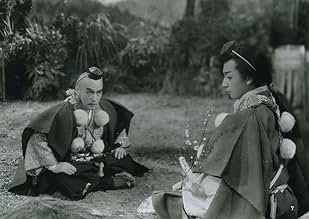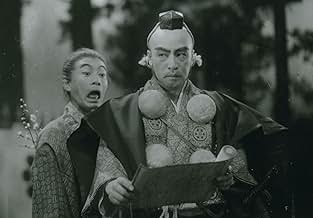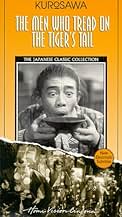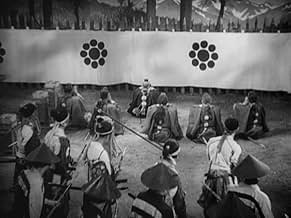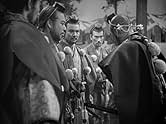Los hombres que caminan sobre la cola del tigre
Título original: Tora no o o fumu otoko-tachi
CALIFICACIÓN DE IMDb
6.7/10
4.7 k
TU CALIFICACIÓN
Japón medieval. Un samurai huye de su hermano. Tanto él como sus guardaespaldas tienen que disfrazarse de sacerdotes para atravesar un bosque y eludir a los guardias de la frontera.Japón medieval. Un samurai huye de su hermano. Tanto él como sus guardaespaldas tienen que disfrazarse de sacerdotes para atravesar un bosque y eludir a los guardias de la frontera.Japón medieval. Un samurai huye de su hermano. Tanto él como sus guardaespaldas tienen que disfrazarse de sacerdotes para atravesar un bosque y eludir a los guardias de la frontera.
- Dirección
- Guionistas
- Elenco
- Dirección
- Guionistas
- Todo el elenco y el equipo
- Producción, taquilla y más en IMDbPro
Opiniones destacadas
I have watched this several times and enjoyed each viewing. It's a very early Kurosawa, apparently done on a shoestring of a budget. However, we can already see Kurosawa's talents in pacing and setting up shots. Kenichi Enomoto as the porter appears out of place at first with his over the top mannerisms and broad comedy, but he fits into the story and breaks up the slower pace of some of the scenes. For Kurosawa and samurai fans, I think this will be more than just a curiosity. This has an early appearance of Masayuki Mori (the murdered husband in Roshomon) and a fairly early appearance of Takashi Shimura (leader of the seven samurai). I recommend this for the usual suspects.
In 1185, the Seike family fights against the Minamoto family. After a bloody naval battle in the Pacific Ocean, Yoshitsune Minamoto (Shubo Nishina) defeats the enemy and the survivals commit suicide. When the triumphant Yoshitsune arrives in Kyoto, his brother, the Shogun Ioromoto, is lured and orders his men to arrest Yoshitsune. However, Yoshitsune escapes with six loyal samurais led by Benkei (Denjirô Ôkôchi) and they head to the country of his only friend Idehira Fukiwara.
Nearby the border, after crossing the forest disguised as monks, their smiley conveyor Suruga (Yoshio Kosugi) discloses that they are Yoshitsune and the six samurais and advises that the fearful Kagiwara and his soldiers are waiting for them in the border to arrest them. Yoshitsune disguises as a carrier and Benkei has to convince Kagiwara that they are six monks traveling to collect donation to build a large temple in Kyoto.
"Tora no o wo Fumu Otokotachi" is the third feature of Master Akira Kurosawa that shows his talent even with very limited budget. The acting is superb and Denjirô Ôkôchi performs a very wise samurai. Yoshio Kosugi is annoying and funny at the same time, with his chuckles. The conclusion is a little disappointing and gives the sensation that the story will be continued. The subtitles in the Brazilian DVD from Continental Distributor have synchronicity problems many times, and I had to use the rewind to read them. My vote is seven.
Title (Brazil): "Os Homens que Pisaram na Cauda do Tigre" ("The Men that Stepped on the Tail of the Tiger")
Nearby the border, after crossing the forest disguised as monks, their smiley conveyor Suruga (Yoshio Kosugi) discloses that they are Yoshitsune and the six samurais and advises that the fearful Kagiwara and his soldiers are waiting for them in the border to arrest them. Yoshitsune disguises as a carrier and Benkei has to convince Kagiwara that they are six monks traveling to collect donation to build a large temple in Kyoto.
"Tora no o wo Fumu Otokotachi" is the third feature of Master Akira Kurosawa that shows his talent even with very limited budget. The acting is superb and Denjirô Ôkôchi performs a very wise samurai. Yoshio Kosugi is annoying and funny at the same time, with his chuckles. The conclusion is a little disappointing and gives the sensation that the story will be continued. The subtitles in the Brazilian DVD from Continental Distributor have synchronicity problems many times, and I had to use the rewind to read them. My vote is seven.
Title (Brazil): "Os Homens que Pisaram na Cauda do Tigre" ("The Men that Stepped on the Tail of the Tiger")
So, seven outlawed noblemen are.... here we see the roots of THE SEVEN SAMURAI. Except that in an hour and writing by himself, Kurosawa winds up concentrating solely on one of them, Denjirô Ôkôchi.
Kurosawa would later note that he preferred to work with other writers, so that other characters could come to the fore. Anyway, they're trying to get past a barrier and to safety in a time of war. Sounds a bit like THE HIDDEN FORTRESS, doesn't it? According to my reading, all of Toho's actresses had been sent out of Tokyo because of bombing. Otherwise he might have made the other movie in 1945. There's surely a hint of it, when the noblemen they are trying to keep safe is said to look like a girl.
Kurosawa would later note that he preferred to work with other writers, so that other characters could come to the fore. Anyway, they're trying to get past a barrier and to safety in a time of war. Sounds a bit like THE HIDDEN FORTRESS, doesn't it? According to my reading, all of Toho's actresses had been sent out of Tokyo because of bombing. Otherwise he might have made the other movie in 1945. There's surely a hint of it, when the noblemen they are trying to keep safe is said to look like a girl.
The movie is seemingly based on an event from Japan's past, but it is really Kurosawa's allegory on Japan's condition at the end of World War Two. A prince, estranged from his brother, and six of his loyal retainers wander through the forest. They all look disheveled and hard up. They must cross a barrier manned by officials who are not exactly friendly to them, before they can move on to improving their life. The prince is disguised as a lowly porter and we rarely see his face. his retainers are warriors but are now forced to don monk's robes and indeed in passing through the barrier manned by the unfriendly forces (read American's) the lead monk must read a treatise in which peace is extolled as the reason for their existence. basically, the monks are Japanese elite, the porter is the Japanese public, the prince is the emperor, the barrier officials are the Americans, whose leader is wise and although he knows the truth allows the monks to live. They are many truths within truths here. Indeed, in the end the adviser to the emperor says, "we must move on (read from the feudal system) if we are to survive". a very fine movie, short yet poignant. one can easily see even in this early feature of his that Kurosawa is a master at symbolic imagery. By the way this movie was made in 1945, but not released in Japan until 1952. After watching it, I can see why it was delayed. It would have been extremely painful as a Japanese citizen to watch this in 1945, with their country in shambles around them. highly recommended.
One can, for the first time, in my opinion, see what Kurosawa could do. He follow a group. of men trying to get through a checkpoint, disguised as priests. Their leader is disguised as a porter and therefore must dishonored to be protected. This is all part of a legend in ancient China and the audiences pretty much knew the story. Kurosawa provides comic relief with the true porter who is an unforgettable character. He is one of those pests that drives one crazy, yet he is so persistent in his efforts to be included. Apparently, historically, things don't bode well for the future but the standoff that occurs as they pretty much risk their lives to get through is quite breathtaking. There are incredible images of the landscape and the use of closeups is vibrant and sharp. The porter's dance at the end is terrific, against a bank of clouds, silhouetted against the sky.
¿Sabías que…?
- TriviaProduction had to be halted briefly during production of the film as Japan surrendered, bringing an end to the hostilities of World War II. Akira Kurosawa recollected breaking during production to listen to the address by Emperor Hirohito on August 15th, 1945.
- ConexionesFeatured in Great Performances: Kurosawa (2000)
Selecciones populares
Inicia sesión para calificar y agrega a la lista de videos para obtener recomendaciones personalizadas
- How long is The Men Who Tread on the Tiger's Tail?Con tecnología de Alexa
Detalles
- Fecha de lanzamiento
- País de origen
- Idioma
- También se conoce como
- The Men Who Tread on the Tiger's Tail
- Locaciones de filmación
- Toho Studios, Tokio, Japón(Studio)
- Productora
- Ver más créditos de la compañía en IMDbPro
- Tiempo de ejecución
- 59min
- Color
- Mezcla de sonido
- Relación de aspecto
- 1.37 : 1
Contribuir a esta página
Sugiere una edición o agrega el contenido que falta

